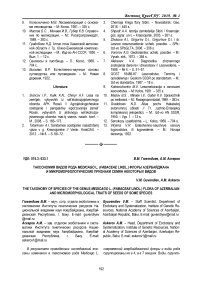Таксономия видов рода Medicago L. (Fabaceae lindl.) флоры Азербайджана и микроморфологические признаки семян некоторых видов
Автор: Гювендиев В.М., Аскеров А.М.
Журнал: Вестник Красноярского государственного аграрного университета @vestnik-kgau
Рубрика: Биологические науки
Статья в выпуске: 1, 2019 года.
Бесплатный доступ
В результате проведенных исследований вне- сены изменения в таксономию рода Medicago L.современной азербайджанской флоры и виды рода сгруппированы не в 4, а в 7 секциях. Виды, сгруппи-рованные в каждой секции, характери-зуются об- щими константными морфологическими призна- ками. Установлено, что в Азербайджане распро- странено 17 видов рода Medicago L. В статье представлена информация о система-тике, биоэкологических особенностях рода и результа- ты исследования микроморфологических особен- ностей семян видов со спорной систематической классификацией. Впервые под электронным микро- скопом (SEM) изучена микроморфология семян 9 видов рода Medicago L. (M. littoralis, M. rigidula, M. truncatula, M. arabica, M. minima, M. polymorpha, M. meyeri, M. orbicularis, M. lupulina), относящихся к 3 секциям (Spirocarpos, Orbiculares, Lupularia). Ста- тус некоторых видов рода Medicago L., относя- щихся к субтрибе Trigonellinae трибы Trifolieae спо- рен, однако различная форма семян, размеры и различный цвет позволяют присвоить самостоя- тельный статус этим видам...
Флора, трибa, род, таксон, ареал, биотоп
Короткий адрес: https://sciup.org/140243339
IDR: 140243339 | УДК: 574.3:
Список литературы Таксономия видов рода Medicago L. (Fabaceae lindl.) флоры Азербайджана и микроморфологические признаки семян некоторых видов
- Аскеров A.M. Растительный мир Азербайджана. -Баку: TEAS PRESS, 2016. -444 с
- Лачашвили И.Я. Люцерны Кавказа. -Тбилиси, 1967
- Флора Азербайджана. Т. 5. -Баку: Изд-во АН Азербайджанской ССР, 1954. -С. 248-265
- Флора СССР. Т. 11. -Ленинград, 1945. -С. 129-176
- Barthlott W. (1981). Epidermal seed surface characters of plants systematic applicability and some evolutionary aspects. Nord. J. Bot., 1: 345-355.
- Bena G. (2001). Molecular phylogeny supports the morphologically based taxonomic transfer of the "Medicagoid" Trigonella L. species to the genus Medicago L. Plant SystEvol 229: pр. 217-236
- Bojňanský V., Fargašová A. (2017). Atlas of Seeds and Fruits of Central and East-European Flora, Amstherdam, Netherlands;. Springer pp. 1046
- Ceter T., Pinar M., Akan H., Ekici M., Aytac Z. (2012). Comparative seed morphology of Trigonella L. species (Leguminosae) in Turkey. Afr. J. Agric. Res. 7 (3): рp.509-522
- Sousa de F., Bertrand Y. J., Nylinder S., Oxelman B., Eriksson J.S., Pfeil B.E. (2014). Phylogenetic properties of 50 nuclear loci in Medicago (Leguminosae) generated using multiplexed sequence capture and next-generation sequencing.
- Small E., Lassen P. & Brenda S. Brokers. (1987). An expanded circumscription of Medicago L. (Leguminosae, Tnifolieae) based onexplosive flower tripping. Source: Willdenowia, pp. 415-437
- Small E. (2011). Alfalfa and relatives. Evolution and classification of Medicago. NRC Research Press, Ottawa, рp.767
- Fawzi N.M. (2011). Macro-and micromorphological seed characteristics of some selected species of Leguminosae. Research Journal of Botany 6: pp. 68-77
- Fayed A.A. and Hassan N. (2007). Systematic significance of the seed morphology and seed coat sculpture of the genus Euphorbia L. (Euphorbiaceae) in Egypt. FL Medit, 17: 47-64
- Gabr D.G. (2014). Seed morphology and seed coat anatomy of some species of Apocynaceae and Asclepiadaceae. Ann.Agric. Sci., 59: 229-238
- Gazara M. Kamel W., Haider A. (2001). Cladistic analysis of the genera: Trifolium, Trigonella and Melilotus (Fabaeeae; Papilionaceae) in Egypt. Egypt J. Biol 3: 161-170
- Guneş F. (2013). Seed characteristics and textures of Pratensis, Orobon, Lathyrus, Orobastrum and Cicercula sections from Lathyrus (Fabaceae) in Turkey. Springer-Verlag Wien., Plant Syst. Evol 299: 1935-1953
- Guneş F., Çırpıcı A. (2011). Seed characteristics and testa textures some taxa of Lathyrus L. (Fabaceae) from Turkey. Int J Agri Biol 13(6): 888-894
- Heneidak S. and Abdel-Khalik K. (2015). Seed coat diversity in some tribes of Cucurbitaceae: implications for taxonomyand species identification. Acta Bot. Bras., 29: 129-142
- Jha S. S. and Aruna P. (1992). Seed Structure In Medicago L. Flora 187: pp. 209-218 Lucknow, İndia
- Jurzysta M., Small E. and Nozzol C. (1988). Hemolysis, a synapomorphic discriminator of an expanded genus Medicago (Leguminosae). Taxon, 37: pp. 354-363.
- Linnaeus C. 1753. Species plantaru Impensis Laurentii Salvii, Stockholm, Sweden., vol. 2, р. 778-781
- Maarten J.M. Christenhusz & James W. Byng (2016). The number of known plants species in the world and its annual increase. Phytotaxa 261 (3): 201-217
- Mirzaei L., Assadi M., Nejadsatari T., Mehregan I. (2015 b.). Comparative seed and leaf micromor-phology of Colutea species (Fabaceae) from Iran. Environ ExpBiol 13: 183-187.
- Oakenfull D. and Sidhu G. S. (1989). Saponins. In Toxicants of plant origin. Vol. 2. Glycosides. Edited by P.R. Cheeke. CRC Press Inc., Boca Raton, Fla. pp. 97-141
- Ozbek F., Ozbek M.O., Ekici M. (2014). Morphological, anatomical, pollen and seed morphological properties of Melilotus bicolour Boiss & Balansa (Fabaeae) endemic to Turkey. Aust J Crop Sci 8 (4): 543-549
- Pinar M. N., Duran A., Ceter T., Tug N. 2009. Pollen and seed Morphology of the Genus Hesperis L. (Brassicaceae) in Turkey. Turk J Bot 83-96
- Small E., Brookes B., Lassen P. (1990). Circum-scription of the genus Medicago (Leguminosae) by seed characters.Can. J. Bot. 68: pp. 613-629
- Teixeira de Q.R., Azevedo de TAM, Lewis G.P. (2013). Seed morphology: anaddition to the taxonomy of Tephrosia (Leguminoseae, Paplionoideae, Millettieae) from South America. Plant Syst. Evol 299:459-470.
- Zoric L., Merkulov L., Lukovic J. and Boza P. (2012). Comparative analysis of qualitative anatomical characters of Trifolium L. (Fabaceae) and their taxonomic implications: preliminary results. Plant Syst. Evol., 298: 205-219


